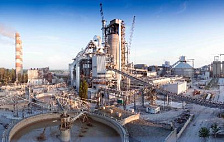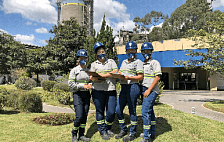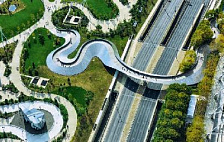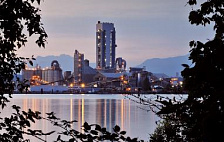Additive construction methods in focus
Hardly any other topic in the construction industry is currently as topical and present in the media as 3D printing of concrete. The implementation of "Industry 2.0" should revolutionize construction and trigger an innovative leap, so it is hoped. The diverse possibilities of directly linking digital planning (Building Information Modeling, BIM) and digital manufacturing processes with industrial robots are almost unlimited. Universities and colleges in Germany are conducting intensive research into the various "additive processes", developing adapted building materials for 3D printing with concrete as well as machines and methods for the automated integration of reinforcement made of steel, glass or carbon.
The following 3D concrete manufacturing processes must be distinguished in principle:
- Gantry Crane (Line Printing by Extrusion)
- Industrial robot (spraying process)
- selective binding
- Truck-mounted concrete pump (print head positioning via GPS, line printing with "normal concrete")
The use of the truck-mounted concrete pump in particular is currently the subject of research at the Forschungsgemeinschaft Transportbeton eV (FTB). In economic terms, 3D printing of concrete offers significant savings potential, especially in terms of construction time compared to conventional construction methods. 3D printing processes also offer the opportunity to counteract the shortage of skilled workers in the construction industry, while at the same time improving the health protection of existing construction site personnel.
Additive manufacturing processes lead to completely new design and geometric freedom for builders and architects. The production of round walls or free-form surfaces is possible with concrete without the cost-intensive formwork effort.
Close cooperation in testing with customers and partners
Röser GmbH, with 6 locations in Baden-Württemberg, is a specialist for concrete shafts, concrete pipes, special components and, as a pioneer, owns the first stationary 3D printer in the Cobod precast plant in Germany. The Danish system manufacturer is part of the group of companies of the formwork specialist PERI in Weißenhorn. The first houses in Germany, in Beckum and Wallenhausen, were printed with identical systems. The press reported extensively on the innovation in concrete construction.
The development and testing of the aggregate-binder compound, with a maximum grain size of 4 mm for the plant in Laupheim, was carried out under the leadership of the SCHWENK R&D team in Karlstadt in close cooperation with the company Röser IV GmbH and SCHWENK Bauberatung . The SCHWENK subsidiary Schretter & Cie GmbH & Co. KG in Vils, Austria, mixes the components and fills the compound into silo vehicles, big bags or as sacks. The building material testing and determination of the material properties on site was carried out by the SCHWENK Technology Center South in Allmendingen.
The challenge and art of formulating is to produce an easily pumpable, homogeneous, plastic mortar by adding only water, which at the same time shows good green strength in connection with a good adhesive bond of the individual printed layers ("layer"), and this at different temperature conditions. After fine adjustments, the combination of these properties was finally successful.
The pre-mixed dry mortar with a water content in a printable consistency has the following parameters and properties:
- Compressive strength according to DIN EN 196-1: > 30 MPa (2 days), > 45 MPa (28 days)
- Flexural strength according to DIN EN 196-1: > 4.5 MPa (2 days), > 7.0 MPa (28 days)
- Freeze-thaw resistance (CDF) according to DIN EN 12390-9: < 200 g/m 2 (28 FTW), < 400 g/m 2 (56 TFW)
Note: The limit for XF4 concrete is ≤ 1500 g/m 2 (28 FTW).
Concrete furniture for the town hall square in Laupheim
With the compound described above, several benches and flower troughs were produced for the city of Laupheim in mid-October 2021 using the 3D printing process. The uniform print image with very good surface quality and layer bonding is to be emphasized here. A beautiful example of the almost unlimited possibilities of shaping concrete in the typical 3D "tree cake" look.
Further investigations on this material should show that the printing of buildings relevant to building regulations is possible within the framework of an approval in individual cases. We will report on this in due course.
If you are interested and have questions about the product, please do not hesitate to contact SCHWENK Bauberatung.








